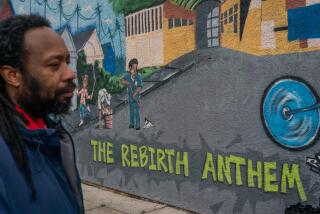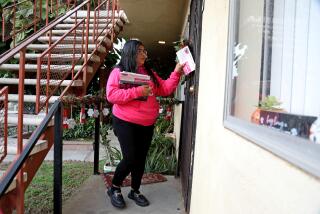Block Parents Help Children in Need When Family Can’t
- Share via
June Cleaver never worried about whether the Beaver would make it home from school OK.
If he and Wally didn’t show up on time for their afternoon milk and cookies, all she had to do was call a couple of her neighbors, and together they would soon locate the boys. Neighborhoods were full of watchful moms in those days, on television and in real life.
But let’s hit the fast-forward button. More likely than not, June Cleaver’s ‘80s counterpart has a job outside the home, at least part time, and so do her neighbors. That means her children may be coming home not only to an empty house, but a nearly empty neighborhood.
Meanwhile, that same sunny street can seem a lot spookier these days, what with warnings everywhere about strangers and drug dealers and pictures of kids on milk cartons. Not to mention plain old-fashioned hazards such as menacing dogs, neighborhood bullies or just getting lost. Where can a child turn if there’s a problem?
In Anaheim, he can look for a block parent, a formalized version of that friendly, helpful neighbor we all took for granted a generation ago. There might not be as many moms available now as there were then, but thanks to the block parent program, the few that are home are more visible and better prepared for emergencies.
Block parents are volunteers--not necessarily parents themselves--who agree to serve as safe bases for kids to go to in emergencies.
They are issued bright pink-orange “Block Parent” signs to post in their street-side windows so that children can find them. But to ensure that they are indeed safe, they and other adults in their households must go through fingerprinting as well as state and federal background checks, according to Carolyn Plettinck, who is responsible for the Anaheim City School District’s block parent program.
Once cleared, block parents are trained to respond appropriately if a child comes to them for help--for their protection as well as the child’s.
For example, block parents are advised not to bring a child into their homes or transport them anywhere in a car, to protect themselves from another ‘80s hazard that ‘50s moms didn’t give much thought to: liability. For the same reason, they are told not to give a child anything to eat or drink.
Children, too, are taught to approach even block parents cautiously.
Last week at Anaheim’s Betsy Ross Elementary School, Plettinck quizzed a group of first-graders on the proper procedures.
“When would you go to a block parent, boys and girls?” she asked. They raised their hands eagerly.
“Like if I was riding my bike and I fell off,” one boy said.
“If your arm hurts when you do this, you would go to a block parent,” said another, wiggling his forearm up and down.
“If a stranger came up and asked if you would like some drugs,” a third boy said quietly.
Then Plettinck did some pretending with a volunteer from the class, teaching him to “take three giant steps back” after knocking on a block parent’s door.
“We should only go into those houses that mom and dad said we could go into,” she said.
Children are also taught when not to ask a block parent for help.
“We only go to block parents when we really, really need them,” Plettinck told the class. “We don’t go to them if we want a drink of water or if we have a tiny little scrape that might need a bandage.
“And we don’t just go by and say ‘Hi!’ ” she said.
Sometimes the children remember the lessons better than the adults, Plettinck says.
“We had one instance a while back where a child was injured from a fall, his face was all bloody, and the block parent wanted him to come in so she could get him cleaned up. And he refused. She was really frustrated, but he did what he was supposed to do,” she says.
But even block parents aren’t home all the time, so Plettinck teaches the children to go to other houses if they get no answer at the block parent’s house.
“If nothing else, it buys them time,” she says. “Parents are still willing to help, regardless, if they see a child in distress.”
The Anaheim program was started more than a decade ago, but it has received more emphasis in the past two years as the district has stepped up its safety program.
Over the years, block parents have intervened in cases of harassment by both children and adults, indecent exposure, vandalism, lost children and injuries. In most cases, the volunteers call parents or police and do not try to track down suspects themselves.
Donna Lake, who has been a block parent for more than 10 years, says she got involved because “it makes you feel like you’re helping a little. There’s so much to worry about out there, there’s sometimes not much you feel you can do to overcome some of these things.”
This year, Plettinck says the district is trying to expand the program. “We’d like to get businesses involved, too, but we haven’t worked out the details of who would be fingerprinted and that sort of thing. And at one of our schools, we’re working on a plan to have block parents at the bus stops in the morning and afternoon.”
More to Read
Sign up for Essential California
The most important California stories and recommendations in your inbox every morning.
You may occasionally receive promotional content from the Los Angeles Times.













